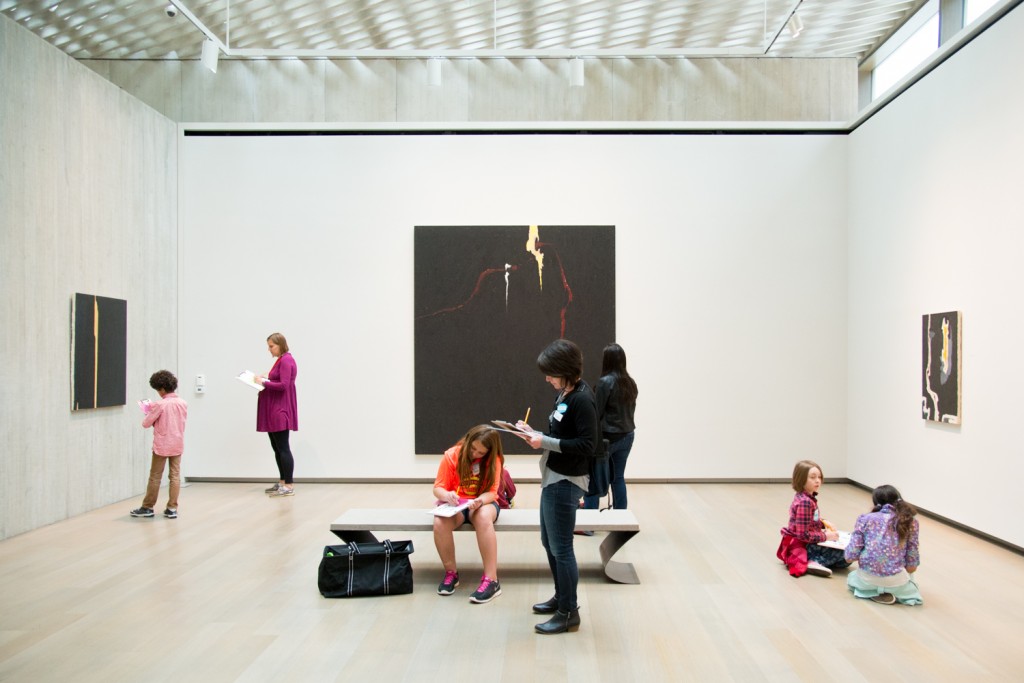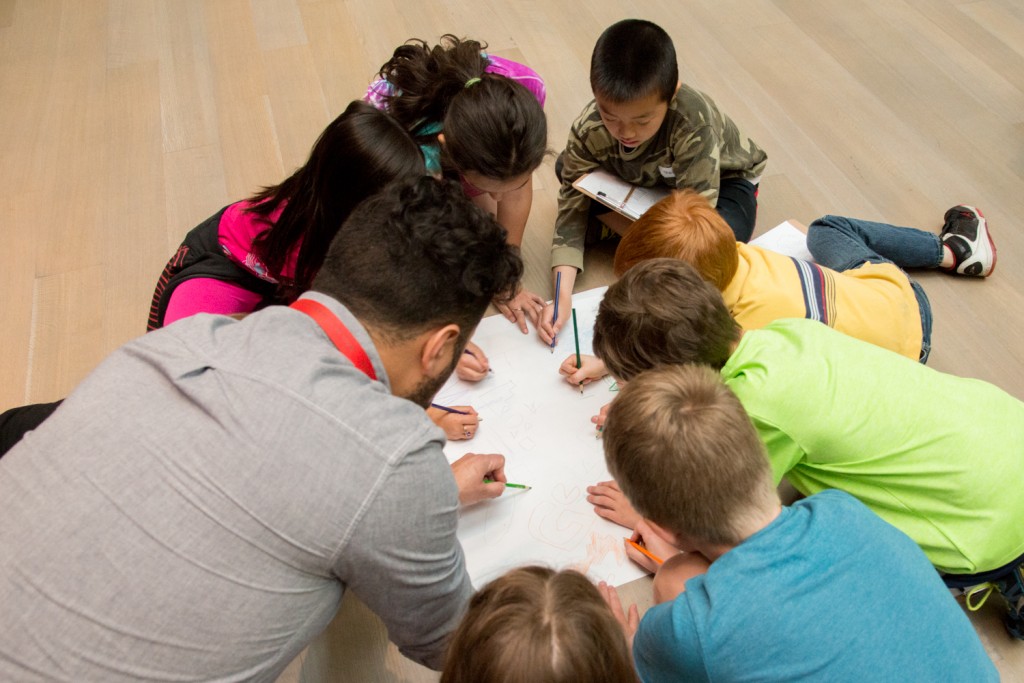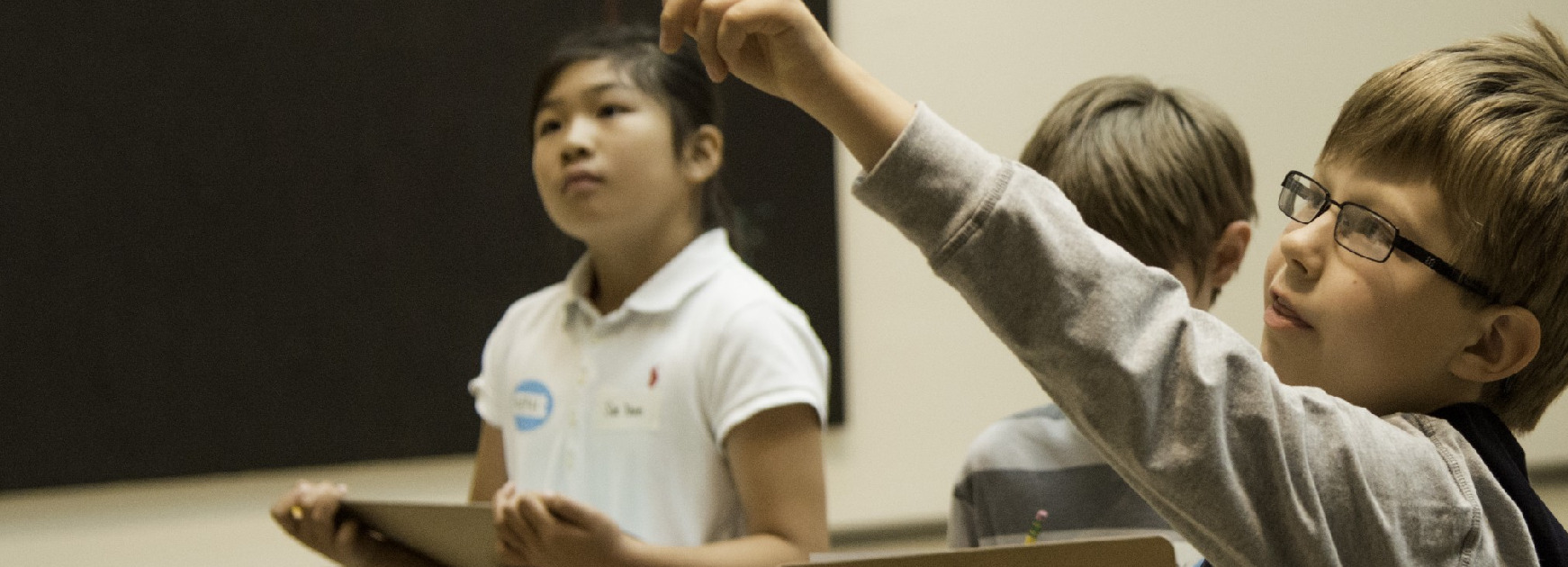By Kristin Feldkamp, Editorial Content Intern
As spring begins, and tiny buds emerge from dormant trees in the Museum’s forecourt, signs of new life to come, we’re thinking about youth and education at the Museum. March is Youth Art Month, a month-long celebration administered nationally by the Council for Art Education that, among many things, “provides a forum for recognizing skills developed through visual arts experiences that are not possible in other curriculum subjects.”
Since the Museum’s inception, youth art education has been an integral part of CSM’s programming. Still was an educator for many years at the college level, first at Washington State College (now Washington State University), and then Richmond Professional Institute (now Virginia Commonwealth University), and the California School of Fine Arts (now San Francisco Art Institute). He even taught briefly at the University of Colorado Boulder. Undoubtedly, he recognized the importance of visual arts education. With this in mind, I sat down with Victoria Eastburn, Director of Education and Programs, to discuss what inspires inStill, CSM’s school visit program, and makes it so unique.
What do you think distinguishes inStill from other museum’s educational programs for school-aged children?
Victoria Eastburn (VE): It’s a combination of four things that really distinguish inStill: the workshop model, an immersive environment, activity-based learning, and our extremely high teacher/student ratio.
- The first one I mentioned, and probably the biggest thing that distinguishes us, is the fact that we’re using something called a workshop model structure instead of a standard tour model. We take inspiration from PEBC’s workshop model because we want students doing most of the talking and thinking. As a structure, workshop really allows that to happen.
- The second distinguishing factor is the immersive environment at the Museum. At CSM, students are immersed in the work and life of a single artist, and that gives them an opportunity to really dig into a single subject or a single person’s work. In one of our “building background knowledge” activities, students read and examine primary source material from Still’s personal archive. Instead of lecturing students about Still, we have them dive into his materials and uncover the content for themselves.
- The third thing that distinguishes our program is the fact that students do activities in the galleries where artwork is on view. So, instead of going on a tour and then to a classroom, students make something in the gallery setting that helps them explore the paintings. For example, in the Choices Artist’s Make lesson, students build background knowledge by using a variety of materials to convey an abstract idea, right there in the gallery. Later in the lesson, when they’re thinking about Still’s artistic choices, they can refer to their own experiences of art making.
- The last thing that distinguishes our program is our unusually high gallery teacher/student ratio. We have on average two CSM gallery teachers per group of six or seven students. By having a high CSM staff-to-student ratio we can differentiate the program according to the needs of individual learners. We’re also able to foster a high level of engagement and inquiry. The high teacher/student ratio is important because, during the student-led work, gallery teachers can confer with students, so there’s a balance of whole-group, small-group, and individualized work.

What are some of the things teachers and students can expect to learn during a visit to the Museum?
VE: We tie every lesson that we facilitate in the Museum to a big overarching idea that applies to art viewing in general. For example, one enduring understanding that we use deals with the importance of understanding the language of art—that in order to read, write and talk about art, we need to understand the language artists use. To that end, we focus on visual elements, visual vocabulary, and the principles of design, and how they relate to interpretation. Another enduring understanding is that there is a relationship between context, history, and art. Those big overarching ideas guide the lessons. Within the lesson, students will uncover traits of Still’s work at the same time that they’re utilizing thinking strategies and exploring art through a particular lens—context and history become entry points to explore art in any setting.
What are your most popular lesson topics and why?
VE: We have several popular lesson topics. One that I’ve already mentioned is called Choices Artists Make. Another is World War II and Abstract Expressionism. A third is about making connections between a person’s biography and art. “Choices” is popular because it’s appealing to get people to think like an artist and it’s a transferable way of thinking about and unpacking art. It can appeal to any level of student, so the lesson is really scalable. World War II and Abstract Expressionism is popular because it’s a way for art and social studies teachers to immediately integrate core content areas. The World War II lesson meets both social studies and literacy standards while working in an art museum setting.
KF: You work with state core requirements to build your curriculum?
VE: All the lessons are standards-aligned for art. Most of them meet literacy standards in addition to that. Some lessons are so integrated they meet art, literacy, and social studies standards in one lesson.
KF: Can you explain what standards-aligned means?
VE: Standards-aligned means there are state and national guidelines that reflect content, skills, and information students should know or be able to do as the result of a unit of study. For teachers to know that they are making good use of their time in the Museum, the Museum provides lessons that meet state and national standards. In addition to standards, we focus on using transferrable thinking strategies and encouraging metacognition. For example, when we have a lesson that uses the strategy of questioning, or when we focus on student inferences and name that strategy with them, those are the same strategies that students in the classroom use to learn how to read and write. One of my favorite comments from an inStill student captures that very idea–the student said that he, “learned how interactive it can be not just to view art, but question it, read it, interrogate it.”
KF: You’re teaching critical thinking skills.
VE: And we’re teaching how to make observations and connections. Our program works to align the strategies we’re teaching with what students are learning in the classroom—with any subject, but in particular with reading and writing. Those strategies are very similar. In many ways, it’s about looking at art as a text. What do I need to do to make meaning out of a piece of art and how does that relate to what I do when I’m reading a novel? We help students build bridges, so they understand that work—that cognitive work of unpacking something—is very similar no matter what the particular text is (book or art). They’re engaging their brain in the same way. A main goal of the program is to get students to recognize how they are engaging their brains so that they can do it again.
CSM has gallery teachers instead of guides. Can you tell me why?
VE: Most of our gallery teachers have a graduate degree, teaching license, or years of experience in the education setting. We want classroom teachers to leave saying, “Oh, wow. They know teaching best practice. They know how to engage my students in a developmentally appropriate way. They know classroom management. They know how to echo and use the signs and symbols that we use in the classroom.” Every aspect of inStill is thoroughly thought out. We worked with several teachers and their students in a multi-visit program to inform our program design. Their input informed our structure, our policies, and even the grade levels we serve. It informed our practice. We chose to do that because we wanted the program to have that foundation—one built on the ideas of students and teachers.

Eastburn’s passion for inStill is visible in every detail of the program. Her quest to develop a top-notch museum education program at CSM that integrates the best of museum and classroom practices is ongoing and began long before CSM opened its doors. Eastburn is a career museum educator with an advanced degree; however, she felt she needed to enhance her experience and education with time in the classroom. Just before joining the CSM team, she spent a year in the classroom earning an initial teaching license through Stanley Teacher Prep. What she saw there amazed her and influenced how she approached developing inStill. inStill is a thriving union between museum and classroom education best practice that Eastburn has carefully honed—and Denver-area students and educators are the lucky beneficiaries.
